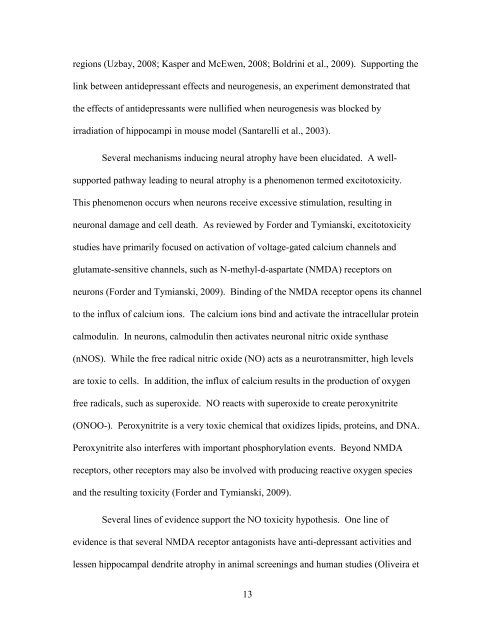INDUCTION OF DEPRESSION BY EXPOSURE TO DAMP ...
INDUCTION OF DEPRESSION BY EXPOSURE TO DAMP ...
INDUCTION OF DEPRESSION BY EXPOSURE TO DAMP ...
Create successful ePaper yourself
Turn your PDF publications into a flip-book with our unique Google optimized e-Paper software.
egions (Uzbay, 2008; Kasper and McEwen, 2008; Boldrini et al., 2009). Supporting the<br />
link between antidepressant effects and neurogenesis, an experiment demonstrated that<br />
the effects of antidepressants were nullified when neurogenesis was blocked by<br />
irradiation of hippocampi in mouse model (Santarelli et al., 2003).<br />
Several mechanisms inducing neural atrophy have been elucidated. A well-<br />
supported pathway leading to neural atrophy is a phenomenon termed excitotoxicity.<br />
This phenomenon occurs when neurons receive excessive stimulation, resulting in<br />
neuronal damage and cell death. As reviewed by Forder and Tymianski, excitotoxicity<br />
studies have primarily focused on activation of voltage-gated calcium channels and<br />
glutamate-sensitive channels, such as N-methyl-d-aspartate (NMDA) receptors on<br />
neurons (Forder and Tymianski, 2009). Binding of the NMDA receptor opens its channel<br />
to the influx of calcium ions. The calcium ions bind and activate the intracellular protein<br />
calmodulin. In neurons, calmodulin then activates neuronal nitric oxide synthase<br />
(nNOS). While the free radical nitric oxide (NO) acts as a neurotransmitter, high levels<br />
are toxic to cells. In addition, the influx of calcium results in the production of oxygen<br />
free radicals, such as superoxide. NO reacts with superoxide to create peroxynitrite<br />
(ONOO-). Peroxynitrite is a very toxic chemical that oxidizes lipids, proteins, and DNA.<br />
Peroxynitrite also interferes with important phosphorylation events. Beyond NMDA<br />
receptors, other receptors may also be involved with producing reactive oxygen species<br />
and the resulting toxicity (Forder and Tymianski, 2009).<br />
Several lines of evidence support the NO toxicity hypothesis. One line of<br />
evidence is that several NMDA receptor antagonists have anti-depressant activities and<br />
lessen hippocampal dendrite atrophy in animal screenings and human studies (Oliveira et<br />
13


